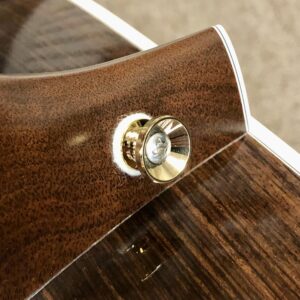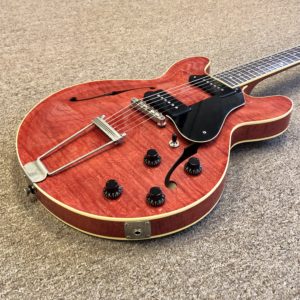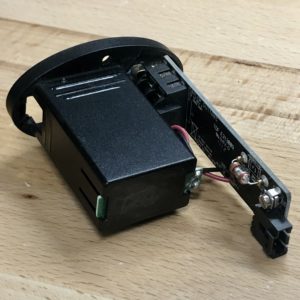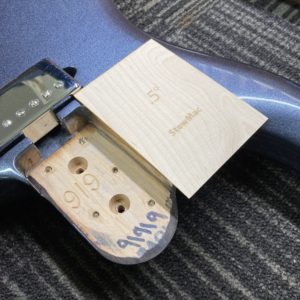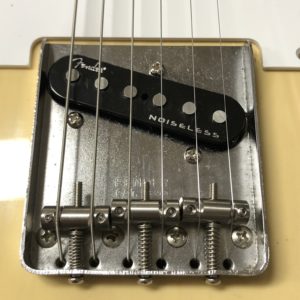Crack Repairs - Repairing Wood Cracks In Guitars
Wood is the most common material for guitar construction. A few particular tree species such as Ebony, Maple, Rosewood Mahogany and Spruce have long been staples within the industry. The type chosen for a particular task is based on a combination of factors such as: availability, tonal qualities, aesthetic beauty, workability, tradition, strength, and durability.
As with anything made of wood, if they are to last, guitars require care and consideration to protect them from damage. Wood cracks can usually be attributed to one of two main causes: Impact (such as a drop or hit) or humidity issues. While the causes may be simple, the variation is nearly endless. The following is an overview of the common ways that wooden guitars can crack and corresponding methods of repair.
Fretboard Cracks
Fretboards (aka fingerboards) that are made from a hardwood like Rosewood or Ebony are typically not sprayed with a protective finish coating. As such, they should be kept clean, oiled, and well humidified to prevent damage.
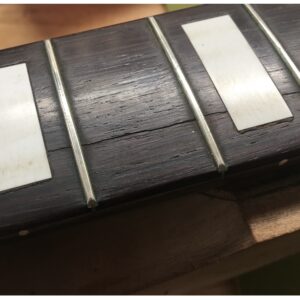
After years of neglect, this old Supro brand guitar had suffered substantial cracking across most of the fretboard’s length.
As the wood shrank, it met resistance from the metal frets and the large rectangular “block” inlays lodged within it; Squeezed past its breaking point, the wood has split to relieve the pressure.
Over time, a network of cracks has travelled up the bass side of much of the fingerboard.
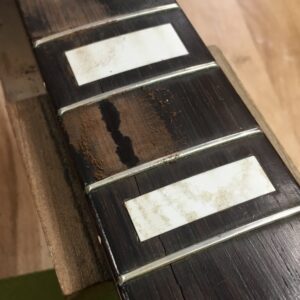
For this repair we are not actually going to rejoin the broken pieces of wood to each other. Instead, we bridge the gap and seal them where they are. This should halt further damage by preventing dirt and moisture from penetrating; It will also make the board feel and look a lot better.
After cleaning, we pack the crack with wood dust and follow it with a thin CA glue. Once dry, we sand it back with extra-fine paper.
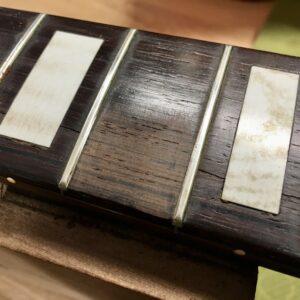
After several applications, the crack is sealed. What was an open void begins to look just like another dark grain line within the wood.
This process is repeated individually for all of the cracks in the fingerboard.
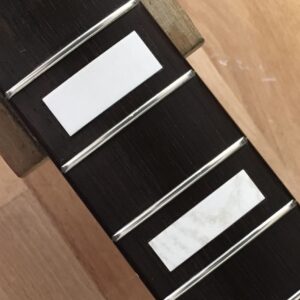
Once the crack has been filled, we set about cleaning and polishing the rest of the fretboard.
Once complete, it has regained a rich, dark, luster that makes it almost unrecognizable. The crack is smooth on the players fingers and has all but disappeared from sight!
Acoustic Guitar Bridge Cracks
The bridge is under tremendous strain from the force of the strings. As such, it is a common failure point either by lifting or cracking. In acoustic guitar construction, the fretboard and bridge are often made of the same species of wood; A dense hardwood like Rosewood or Ebony that is not covered with a protective finish coating.
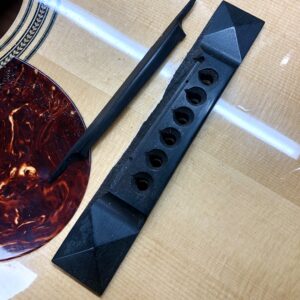
This bridge is in rough shape! The front edge of the saddle slot has broken free; it can no longer hold the saddle, rendering the instrument unplayable.
Acoustic guitar bridge cracks may start as a subtle hairline split near the saddle or through the string mounting pin holes, before suffering a catastrophic failure such as in the photo.
A cracked bridge is often a sign of some other issue with the guitar that must be dealt with. It could be a symptom of trouble with the bridge plate, an over-set neck, a poorly fit saddle or bridge pins, etc.
A cracked bridge nearly always requires replacement. While a quicker fix such as gluing or sealing the crack may be tempting, these repairs are unlikely to hold up long term. An acoustic guitar bridge must bear the constant weight and tension of the strings. It is essential that it be absolutely solid.
In this case, the fine folks at Huss and Dalton were extremely helpful in getting us a replacement bridge for their instrument. With vintage guitars, a replacement may have to be made from scratch; A difficult and expensive repair.
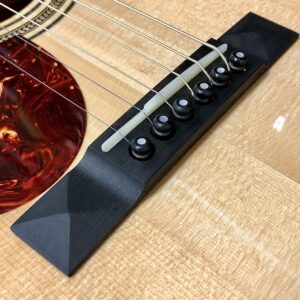
Top / Soundboard Cracks
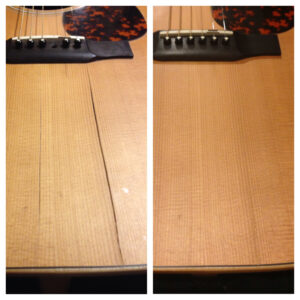
Acoustic guitar top cracks are perhaps the most common crack repair request that we receive in shop. Acoustic guitar tops are typically made from Spruce, which is soft, light, and resonant. While less durable than other hardwoods, its function as the soundboard of the instrument requires that other attributes take precedence.
Top cracks are often the result of storage in overly dry conditions. These cracks usually respond well to re-humidification, bringing the edges close enough together to be glued with the aid of specialty clamps and cauls. If a top crack is present, it is important to examine the instrument’s internal bracing, as it my also be compromised.
Finish touchup is often a concern with this type of crack. While some, such as the satin finish on this Larrivee, are fairly forgiving, others may be difficult to hide without extensive touchup or refinishing work.
Pickguard Cracks
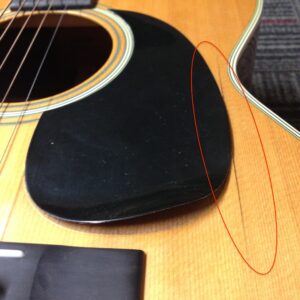
A special type of top crack, near the edges of acoustic guitar pickguards, is fairly common among vintage instruments. As the biggest and most collectable company of the era, this familiar break pattern is sometimes dubbed “The Martin Crack”.
The damage results from the shrinking of aging pickguard materials that had been adhered to the wood top. In addition to gluing the cracks, proper repair requires removal and replacement of the shrinking pickguard. We’ve discussed this at some length in our article on Vintage Acoustic Guitar Pickguard Replacement.
Splining a Crack
After rehumidification, most humidity related splits will close up enough to allow the edges to be rejoined and glued together. On rare occasions, the split will not close completely. In these situations, a new piece must be inserted into the gap.

What is shown here is not technically a crack, but a seam separation. An acoustic guitar top is typically made of two pieces of wood that have been glued together in the center. This glue joint is called the “center seam”. Sometimes the joint fails, leaving a straight sided gap down the middle of the instrument.
After an extended period of rehumidification, the gap simply would not close tight enough to be re-glued.
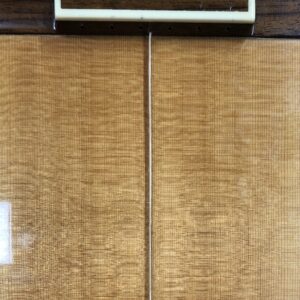
Since this guitars top is made of Spruce, we carefully split and shaped a sliver of matching material to fit the gap in the guitar’s top. This piece is called a “spline”.
We glue it in position to permanently close the troublesome separation.
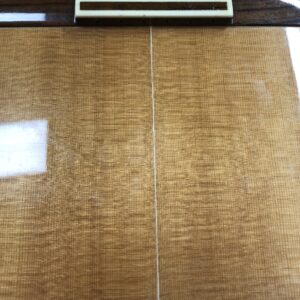
Once glued in place, we trim the excess down flush with the top. At this stage, the gap is closed, but the white piece of fresh, unfinished, spruce sticks out like a sore thumb next to the aged finish on the rest of the instrument.
It must be touched-up with an application of finish to protect and (hopefully) blend it in with its surroundings.
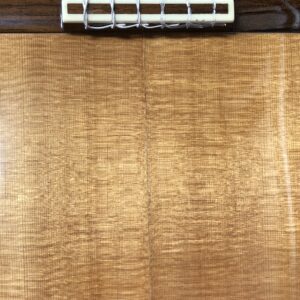
Matching color and applying finish to wood is an art unto itself. With a simple aged clear finish like this, we were able to pull off a passable match. On a colored or sunburst finished instruments it can be very difficult to hide this type of repair!
Back and Side Splits
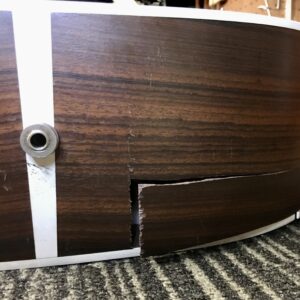
An instrument’s back and sides are usually made of matching material, often a hardwood like rosewood or mahogany.
While their purpose in the instrument is to provide structure and rigidity, the sides must also be thin and flexible enough to withstand their bending to the curved shape of the guitar’s body.
While humidity cracks are also possible here, many times these cracks are the result of impact. In the photo, the instrument was dropped on its endpin, causing the crack you see a few inches to the side of it.
Cracks to the instrument’s back and sides are complicated by the difficulty in effectively applying clamping pressure during gluing.
Like the soundboard, a guitar’s back and sides will also be coated with a protective finish. As such, repairs to breaks in these areas would require finish work to hide the scars.
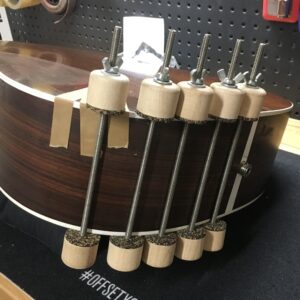
Complex cracks and breaks
Complex breaks are typically the unfortunate result of a drop or hit.The force of the blow radiates through the instrument and can cause multiple points of failure. The shockwave may compress wood fibers in some areas while other pieces may be sent splintering out of the instrument, perhaps never to be found.
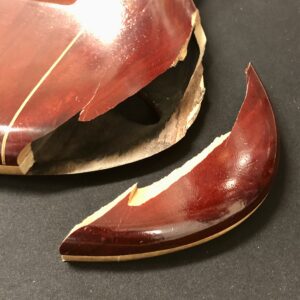
This Ibanez bass was accidentally dropped. The resulting damage produced several breaks in the wood. Upon arrival, the large crescent shaped piece shown in the photo was still in position but was mostly detached. We were able to carefully wiggle it free from the instrument in order to make the necessary repairs.
Jobs like this must be planned out and executed in several stages. The broken pieces must be reassembled, in the right order, a bit at a time.
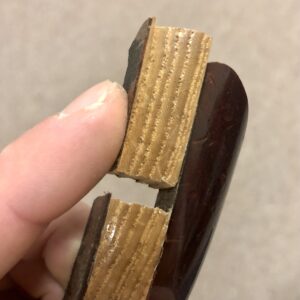
The body of this instrument was constructed out of multiple layers of wood, called lamination. Lamination can be done either to increase the material’s strength, or simply for the aesthetic beauty of the resulting woods contrasted against one another.
On this instrument, the top is made out of an exotic wood called Bubinga. The lighter colored wood along the side is Ash, and the back is made from Mahogany.
Here we see where a small block of wood from the laminated body needed to be glued to the larger crescent shaped piece shown in the first photo.
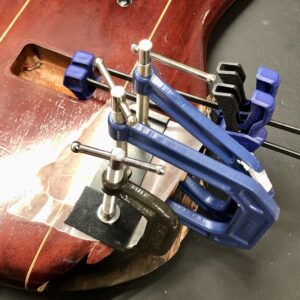
We also had to deal with several cracks and separations on the main body of the instrument. Each required a unique clamping setup to secure it in position while the glue set.
Since each glue-up takes several hours to dry, these types of jobs can take several days to complete.
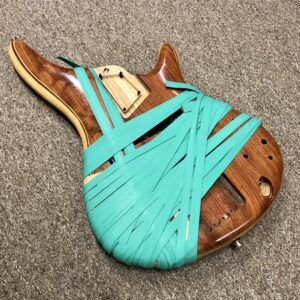
Fitting the large crescent shaped chunk back to the body required the application of even pressure on all sides. Unfortunately, the sleek, rounded, profile of this bass did not make for a good clamping surface.
Here we used large bands, stretched across the surface, to securely grip the piece in position while the glue dried.
The completed repair is not without scars, but is back in one piece, functional, and stable.
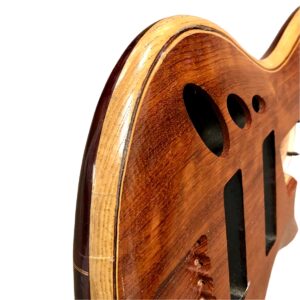
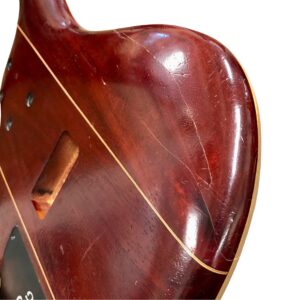

Erik Salomon - Calico Guitarworks Owner / Head Technician
Tech Talk articles are part of an ongoing effort to provide clear and detailed answers to common questions about guitar maintenance, modifications, and repairs.
While not intended as a step-by-step guide to servicing your own instrument, we hope that you will find value in the information provided.

Great Repairs Start With The Right Parts
Many of the parts mentioned in our blogs are available for purchase at:
GuitarRepairParts.com
Enter the code "TechTalk10" at checkout for 10% off your first order.
About Calico Guitarworks
Calico Guitarworks is the area’s premier destination for fretted musical instrument care and maintenance. Owned and managed by Erik Salomon, the shop is dedicated to providing quick, honest and reliable service. The staff at Calico Guitarworks has a combined 25+ years of professional guitar repair experience. Sharing the knowledge that we accumulate in this focused pursuit is at the core of what we do. Learn more About Calico Guitarworks, explore our Frequently Asked Questions, or Contact us with a specific request.

